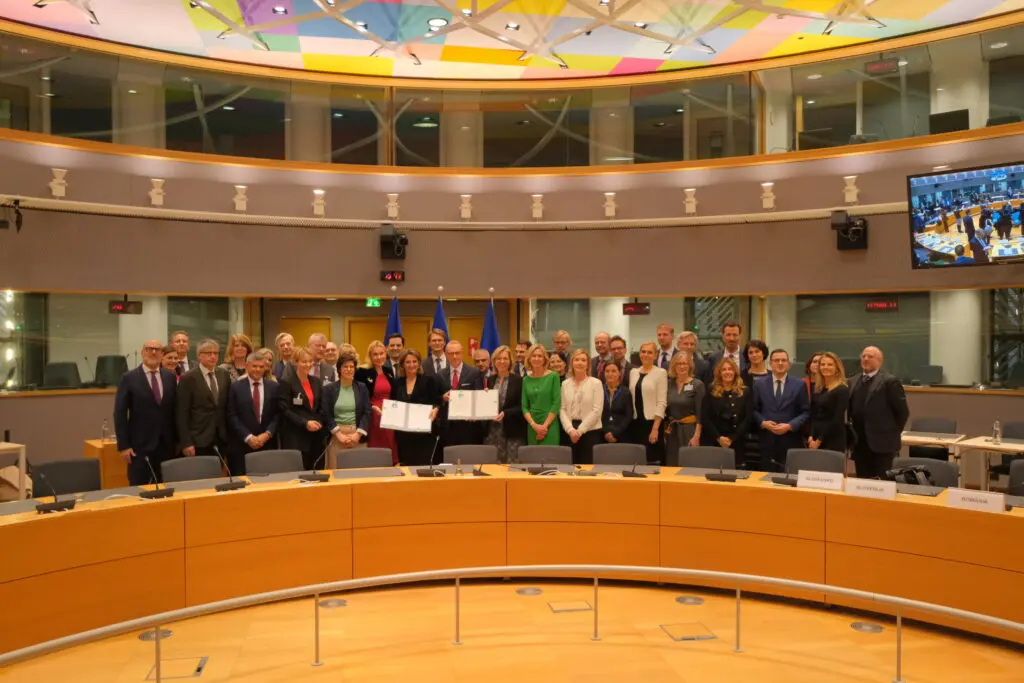The European Union (EU) Commission, 26 Member States, and more than 300 companies have signed the European Wind Charter. The charter follows the EU`s Wind Power Action Plan that was published by the EU Commission in October. The plan is a non-regulatory communication. Signing the charter, the member states commit to deliver on the goals of the Wind Power Action Plan. Also, the wind industry commits to Europe as a region for growth and scale up.
Achieving the recently agreed EU target of at least 42.5% renewable energy by 2030, with an ambition to reach 45% set in the revised Renewable Energy Directive (RED), will require a massive increase in EU wind installed capacity. A resilient, sustainable, and competitive EU wind supply chain is necessary to more than double the current deployment rate and provide security of supply. However, while the wind power sector is historically an EU success story, it faces a set of challenges. The whole European wind ecosystem needs to come together to address these challenges, ensuring the clean energy transition goes hand-in-hand with industrial competitiveness and that the whole EU wind power sector continues to prosper, maintaining competitiveness and employment throughout the whole value chain in Europe. The European Wind Power Action Plan sets out immediate actions to be taken by the commission, member states, and industry. This Wind Charter builds on the action plan, constitutes a coordinated effort and a common vision to improve the enabling conditions for the European wind industrial ecosystem and aims to align and swiftly implement the actions of the European Commission, member states, and the wind sector.
The charter includes the following commitments:
- Ensure a sufficient, robust, and predictable pipeline for the deployment of wind energy, including through updated national energy and climate plans (NECPs) coherent with the more ambitious Fit-for-55 renewable energy targets, faster and more predictable permitting in the framework of the Emergency Regulation on Permitting, by prioritizing the transposition and implementation of the revised Renewable Energy Directive and providing higher visibility to future auctions and long-term plans for wind deployment. The undersigning member states and representatives from the wind sector will commit to strengthening their collaboration on identifying barriers in permitting procedures. They will work together and with the commission in identifying potential new ways to accelerate permitting further. The undersigning member states will submit their individual pledges on the wind energy deployment volumes covering at least the period of 2024 through 2026 alongside this Wind Charter.
- Improve, simplify, and provide consistency in the design of auctions for wind energy in order to promote the production of high-quality wind turbines with high environmental, innovation, cybersecurity, and labor standards and to address shortcomings resulting in project delays or abandoning. While continuing to aim for competitive energy prices for consumers, this will be done, amongst other, through well-designed, objective, transparent, non-discriminatory, non-price prequalification or award criteria that promote or reward higher value-added products, increase the resilience of the European supply chain, and promote industrial scale-up, better supporting an innovative and competitive EU wind manufacturing industry. Without prejudice to the outcome of the legislative process concerning the Net-Zero Industry Act, the above would, in particular, include an auction design that includes objective, transparent, and nondiscriminatory non-price criteria, especially regarding sustainability and resilience, cybersecurity, business conduct, and ability to deliver. Citizen participation could also be taken into account. Qualitative criteria would be designed, taking into consideration administrative burden and sufficient flexibility in order not to affect the realization of renewable energy projects. The undersigning member states commit to working together and with the commission to ensure that the interpretation and application of these qualitative criteria are open, transparent, do not distort the EU-wide level playing field, are compatible and coordinated with state aid rules.
- Ensure that business processes, governance, products, and services offered by the undersigning wind sector representatives satisfy high qualitative standards related to environment, innovation, cybersecurity, and labor conditions that are in line with the objective of the Net Zero Industry Act and the Wind Power Action Plan, including for projects developed through power purchase agreements or those participating directly in wholesale markets. To facilitate the conclusion of such power purchase agreements, the undersigning member states commit to the removal of remaining barriers to their conclusion in line with legal requirements under EU law, including through, where relevant, Union level instruments, aimed at reducing financial risks.
- Improve the predictability of demand and supply, smoothing the effect of volatile prices and ensuring project implementation, in particular by hedging against inflation and price volatility of main costs, and, for private actors especially, developing long-term partnerships aimed at providing a stable and predictable outlook for the supply of equipment. This would include clear auction schedules, a commitment to take appropriate measures to maximize the execution rate of wind projects through appropriate incentives including penalty clauses for non-execution of projects as well as developing further long-term partnerships between wind manufacturers and wind operators which can be of mutual benefit.
- Contribute to a fair and competitive international environment by actively monitoring and, if justified, consider measures to address possible unfair trade practices in the international market for wind-related products and cooperating on investments in the wind sector under the framework of the Foreign Direct Investment Regulation, and other appropriate instruments.
- Scale up wind equipment manufacturing capacity in EU to meet the expected increased demand for wind projects, whilst committing to reinforcing existing employment and industrial capabilities, as necessary. This will be carried out by stepping up investments and ensuring the expansion of manufacturing capacity in the EU in the mid-term in line with the EU deployment targets, including as set out in NZIA, and committing to a net-positive employment impact by, amongst others, adequate workforce management including supporting the up-skilling and re-skilling of workers to ensure a sufficient and skilled workforce in the wind sector.


